Choosing your organization’s “Vital Few” and achieving breakthrough performance
Posted on October 3, 2019

Joseph Juran was the first engineer to apply the Pareto principle as a quality management tool, demonstrating that ~20% of issues contributed to ~80% of a problem or opportunity. Building on this principle, Juran referred to the ~20% as the “Vital Few” and the remaining ~80% as the “Trivial Many.” In our consulting practice, we further apply this principle by using the term “Vital Few” to indicate an organization’s highest priority areas of opportunity.
Executives in today’s complex business environment are faced with hundreds of tasks that need to be done. Many leaders have a seemingly endless list of projects, with most at risk or behind schedule. The most challenging, but most important questions to answer are: “Which initiatives should be prioritized first?” And furthermore, “Do we really need to readjust all of them, or can some tasks slip at the benefit of ensuring the most impactful projects are accomplished?” The choice towards a “Vital Few” and away from the “Trivial Many” is not easy, but it offers the best chance at meaningfully changing performance.
As leaders select their “Vital Few,” the opportunities should be big steps that, over time, will take their organization to a new place. In this application to strategy, we also test each prospective “Vital Few” opportunity against the organization’s vision statement. When choosing between options, we query which will most efficiently and effectively take a business to its ideal future state. Absent this disciplined approach to strategy, progress will likely be incremental, rather than breakthrough.
We have found through our experience that identifying the right breakthrough opportunities and driving leadership alignment around the “Vital Few” will lead to significantly improved focus and increased odds of moving the needle on an organization’s strategy.
#VitalFew
#HPMS
#Haffeyco
#Juran
#Pareto
#medtech

